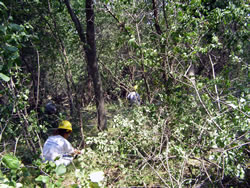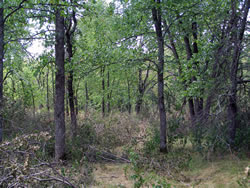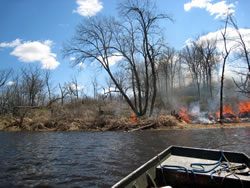National Cohesive Wildland Fire Management Strategy Success Story
Coordinated Efforts Help to Restore Native Prairies and Oak Savannas at Park
Saint Croix National Scenic Riverway, Wisconsin
Cohesive Strategy - Maintain and Restore Landscapes
2011

Minnesota Conservation Corps crew cutting buckthorn, first treatment.

Slash leftover from the cutting.

Spring 2011 prescribed fire.
Restoration of our native fire dependant ecosystems often involves more than the reintroduction of fire. Many sites are now inundated with invasive species that must be controlled throughout the restoration process in an integrated fashion. This can be a difficult maneuver since each species may require different tactics to control while at the same time native species must be conserved. Managers at St. Croix National Scenic Riverway are all too familiar with this issue. Several tallgrass prairies and oak savannas at the Riverway are slated for restoration and all have invasive species issues to some extent.
One such site is a 200-acre Peaslee Island on the St. Croix River. The site contains a rare oak barrens community. Much of the barrens community was overgrown with European buckthorn and Tartarian honeysuckle. The restoration has required numerous mechanical, fire, and herbicide treatments.
The initial treatment involved cutting the buckthorn and honeysuckle and treating the stumps with herbicide. This was started by a Student Conservation Association (SCA) crew and resource management staff in 2006. Youth crews from Conservation Corps Minnesota continued this work in 2007 and finished in 2009. Without this initial treatment it would be impossible for fire to carry through the site given the microclimate and inflammable litter created by these species.
Fire was applied in 2009 following the mechanical treatments to kill any new buckthorn regeneration and clean up slash piles left by the cutting. The site was burned again two years later in the spring of 2011, to top kill any remaining buckthorn and stimulate grass in the newly opened areas. The following fall the Great Lakes Exotic Plant Management Team (EPMT) treated any buckthorn and honeysuckle resprouts with herbicide.
The restoration of the site is still far from complete, as it will take several more treatments of fire and herbicide to control the invasives. In the near future, the site may be seeded with native prairie grasses, which will serve two purposes. First, it will re-establish a native plant community and second, it will increase fire spread rates and intensity making it more difficult for buckthorn and honeysuckle to persist.
Key factors in the success of this restoration are the integrated timing of each treatment and the coordinated efforts of resource management, the EPMT and the fire program staff.
Contact: Scott Weyenberg, Fire Ecologist, Great Lakes Eco-region, (715) 483-2285.